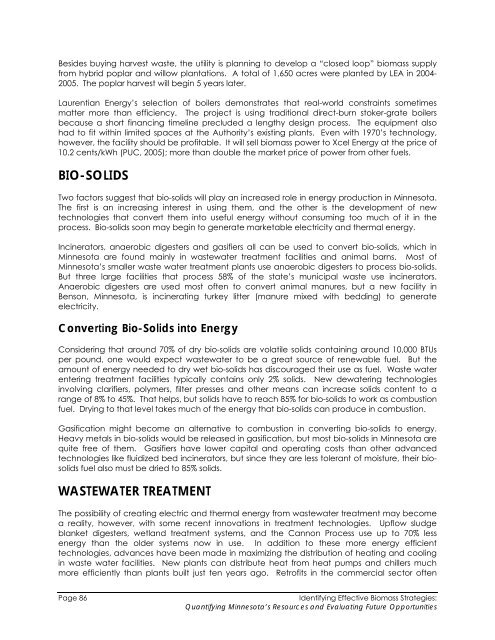Biomass Feasibility Project Final Report - Xcel Energy
Biomass Feasibility Project Final Report - Xcel Energy
Biomass Feasibility Project Final Report - Xcel Energy
Create successful ePaper yourself
Turn your PDF publications into a flip-book with our unique Google optimized e-Paper software.
Besides buying harvest waste, the utility is planning to develop a “closed loop” biomass supply<br />
from hybrid poplar and willow plantations. A total of 1,650 acres were planted by LEA in 2004-<br />
2005. The poplar harvest will begin 5 years later.<br />
Laurentian <strong>Energy</strong>’s selection of boilers demonstrates that real-world constraints sometimes<br />
matter more than efficiency. The project is using traditional direct-burn stoker-grate boilers<br />
because a short financing timeline precluded a lengthy design process. The equipment also<br />
had to fit within limited spaces at the Authority’s existing plants. Even with 1970’s technology,<br />
however, the facility should be profitable. It will sell biomass power to <strong>Xcel</strong> <strong>Energy</strong> at the price of<br />
10.2 cents/kWh (PUC, 2005); more than double the market price of power from other fuels.<br />
BIO-SOLIDS<br />
Two factors suggest that bio-solids will play an increased role in energy production in Minnesota.<br />
The first is an increasing interest in using them, and the other is the development of new<br />
technologies that convert them into useful energy without consuming too much of it in the<br />
process. Bio-solids soon may begin to generate marketable electricity and thermal energy.<br />
Incinerators, anaerobic digesters and gasifiers all can be used to convert bio-solids, which in<br />
Minnesota are found mainly in wastewater treatment facilities and animal barns. Most of<br />
Minnesota’s smaller waste water treatment plants use anaerobic digesters to process bio-solids.<br />
But three large facilities that process 58% of the state’s municipal waste use incinerators.<br />
Anaerobic digesters are used most often to convert animal manures, but a new facility in<br />
Benson, Minnesota, is incinerating turkey litter (manure mixed with bedding) to generate<br />
electricity.<br />
Converting Bio-Solids into <strong>Energy</strong><br />
Considering that around 70% of dry bio-solids are volatile solids containing around 10,000 BTUs<br />
per pound, one would expect wastewater to be a great source of renewable fuel. But the<br />
amount of energy needed to dry wet bio-solids has discouraged their use as fuel. Waste water<br />
entering treatment facilities typically contains only 2% solids. New dewatering technologies<br />
involving clarifiers, polymers, filter presses and other means can increase solids content to a<br />
range of 8% to 45%. That helps, but solids have to reach 85% for bio-solids to work as combustion<br />
fuel. Drying to that level takes much of the energy that bio-solids can produce in combustion.<br />
Gasification might become an alternative to combustion in converting bio-solids to energy.<br />
Heavy metals in bio-solids would be released in gasification, but most bio-solids in Minnesota are<br />
quite free of them. Gasifiers have lower capital and operating costs than other advanced<br />
technologies like fluidized bed incinerators, but since they are less tolerant of moisture, their biosolids<br />
fuel also must be dried to 85% solids.<br />
WASTEWATER TREATMENT<br />
The possibility of creating electric and thermal energy from wastewater treatment may become<br />
a reality, however, with some recent innovations in treatment technologies. Upflow sludge<br />
blanket digesters, wetland treatment systems, and the Cannon Process use up to 70% less<br />
energy than the older systems now in use. In addition to these more energy efficient<br />
technologies, advances have been made in maximizing the distribution of heating and cooling<br />
in waste water facilities. New plants can distribute heat from heat pumps and chillers much<br />
more efficiently than plants built just ten years ago. Retrofits in the commercial sector often<br />
Page 86<br />
Identifying Effective <strong>Biomass</strong> Strategies:<br />
Quantifying Minnesota’s Resources and Evaluating Future Opportunities

















